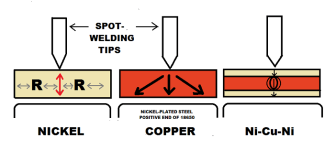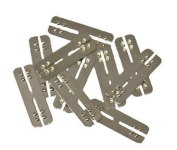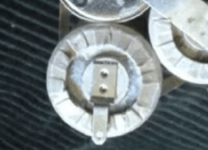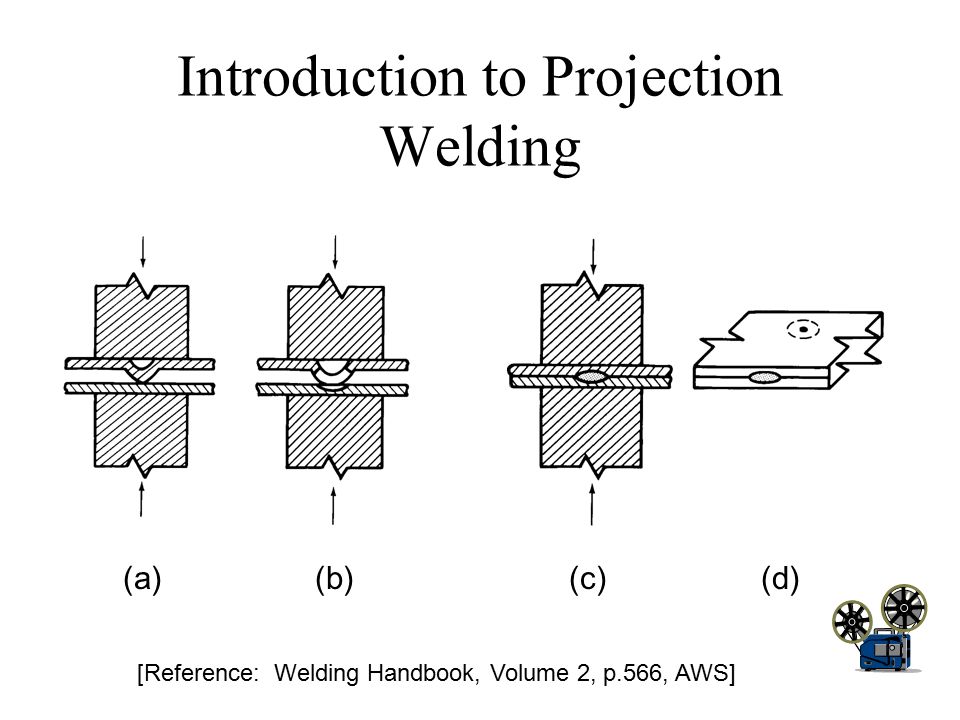I am now convinced more than ever that the positive end of an 18650 / 21700 cell can take quite a bit of abuse. However, the negative end is sensitive to heat, with the most common culprit being a high-watt soldering iron. I accept that the BEST method is ultrasonic wire-bonding (Tesla, Alta, LunaWolf)...but the equipment is very expensive, and I see no opportunities for progress in developing a home DIY ultrasonic bonding unit. That leaves negative end DIY connection options:
Soldering a fuse-wire (the least desirable, but less heat than soldering an 8mm wide nickel ribbon)
Compression over ribbon-bus, with nickel-plated copper...this deserves future experimentation...
Spot-welding at the lowest possible heat.
xxxxxxxxxxxxxxxxxxxxxxxxxxxxxxxxxxx
There was a post a while back by a company shill from SigmaCLAD, and even though it was PR, there was useful info buried inside it. The 15A-20A 18650 cells found inside cordless tools are the cells that we most want in our ebike battery packs. Makita, DeWAlt, Metabo and others use nickel-plated copper, BUT...they also use a laser spot-welder ( https://www.fkdelvotec.com/fileadmin/media_fuk/dokumente/FK_ElectricHybrid_2017_07.pdf ), which nobody here is suggesting the average DIY garage builder would even dream of buying. So...now back to SigmaCLAD. Their bus material has a fairly thick outer shell of nickel and stainless steel (thicker than common nickel-plating). It has a copper core to handle higher operating currents, and to also draw heat away from the cell-tip as a cooling element.
I recently found a youtube of a builder who used a 2-layer bus of copper and nickel ( https://endless-sphere.com/forums/viewtopic.php?f=14&t=84680&start=175#p1470809 ). The shell of a common 18650 cell is nickel-plated steel. The steel core of the 18650 body (electrodes) has such a higher resistance than the nickel-plating that I suspect the majority of the current in 18650 cells flows through the nickel skin. That is the type of realization that is prompting this thread.
Why does spot-welding nickel easily work, but trying to spot-weld copper or aluminum end up being so hard? I think it is because the high conductivity of the copper/aluminum allows the current to. Here's a drawing to illustrate my theory

On the left, the bus is pure nickel (thickness exaggerated to help illustrate). The large "R" indicates resistance, which influences the spot-welding current to take a short direct path.
The middle is pure copper, on the right is copper-core, with thick nickel on the top/bottom
https://ieeexplore.ieee.org/stamp/stamp.jsp?arnumber=8642823
Soldering a fuse-wire (the least desirable, but less heat than soldering an 8mm wide nickel ribbon)
Compression over ribbon-bus, with nickel-plated copper...this deserves future experimentation...
Spot-welding at the lowest possible heat.
xxxxxxxxxxxxxxxxxxxxxxxxxxxxxxxxxxx
There was a post a while back by a company shill from SigmaCLAD, and even though it was PR, there was useful info buried inside it. The 15A-20A 18650 cells found inside cordless tools are the cells that we most want in our ebike battery packs. Makita, DeWAlt, Metabo and others use nickel-plated copper, BUT...they also use a laser spot-welder ( https://www.fkdelvotec.com/fileadmin/media_fuk/dokumente/FK_ElectricHybrid_2017_07.pdf ), which nobody here is suggesting the average DIY garage builder would even dream of buying. So...now back to SigmaCLAD. Their bus material has a fairly thick outer shell of nickel and stainless steel (thicker than common nickel-plating). It has a copper core to handle higher operating currents, and to also draw heat away from the cell-tip as a cooling element.
I recently found a youtube of a builder who used a 2-layer bus of copper and nickel ( https://endless-sphere.com/forums/viewtopic.php?f=14&t=84680&start=175#p1470809 ). The shell of a common 18650 cell is nickel-plated steel. The steel core of the 18650 body (electrodes) has such a higher resistance than the nickel-plating that I suspect the majority of the current in 18650 cells flows through the nickel skin. That is the type of realization that is prompting this thread.
Why does spot-welding nickel easily work, but trying to spot-weld copper or aluminum end up being so hard? I think it is because the high conductivity of the copper/aluminum allows the current to. Here's a drawing to illustrate my theory

On the left, the bus is pure nickel (thickness exaggerated to help illustrate). The large "R" indicates resistance, which influences the spot-welding current to take a short direct path.
The middle is pure copper, on the right is copper-core, with thick nickel on the top/bottom
https://ieeexplore.ieee.org/stamp/stamp.jsp?arnumber=8642823




